
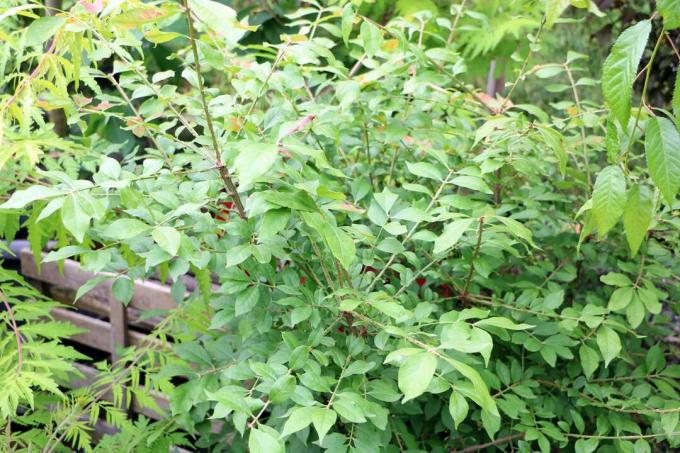
Table of contents
- Characteristics
- Location
- Floor
- Plant
- Best planting time
- tub planting
- plant neighbors
- Pour
- Fertilize
- Cut
- wintering
- propagation
- sowing
- propagation by cuttings
- Saplings / root suckers
- Diseases
- pests
Spindle trees thrive with lots of flowers if they are cared for properly. Find out more about the plant in the profile and find out everything you need to know about the care measures.
Characteristics
- scientific name:euonymus
- Family: Spindle tree family (Celastraceae)
- growth height: about three meters; some varieties as trees up to six feet
- Blossoms: white-green; from May to June
- Fruit: pink to red; from September to October
- decorative autumn coloring
- deciduous
- hardy
- highly toxic
Location
In terms of the perfect location, the spindle tree does not make any great demands. The spindle shrub is very tolerant, especially when it comes to the required light. If the location fulfills the following characteristics, nothing stands in the way of healthy growth and lush flowering:
- Light conditions: between full sun and partial shade; reduced number of flowers in full shade
- warm, sheltered environment
- Sufficient space for a growth height of up to six meters and a crown width between 1.5 and two meters
- out of the reach of children and pets, since poisonous
Floor
In theory, a euonymus will thrive in any type of soil. If you want the best soil conditions for new planting or transplanting, pay attention to:
- looseness
- nutrient and humus rich soil
- calcareous soil; the more lime the better
- do not plant in heavy clay soil as there is a high risk of waterlogging
- dry to moist, but not waterlogged
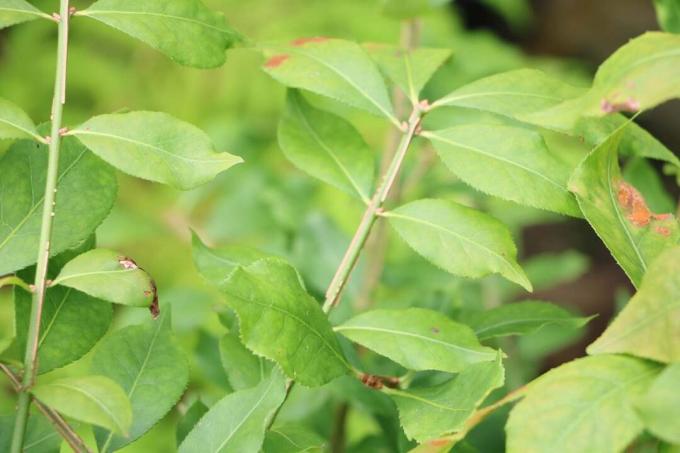
Plant
Once the right location has been found, planting can begin. Proceed as follows:
- Loosen the soil over a large area before planting
- Planting hole size: Width and depth 1.5 to twice the root circumference/ball
- Lay drainage out of gravel or other suitable material on the ground
- Mix the excavated soil generously with hummus
- Mix in sand for heavier soils
- When planting hedges, keep a planting distance of about 50 centimeters
- Insert the plant, fill up with soil and press down only slightly (otherwise risk of root damage)
- water generously and keep the soil evenly moist for the following weeks
Best planting time
Spine hats can be planted all year round as long as there is no ground frost. However, the best time to plant bare-root specimens is spring. This is where the vegetation period begins, which stimulates root formation and accelerates solid growth. Ball plants are also best planted in spring, but can also be planted in fall. When planting in the fall, care should be taken that the first frost is still some way off. This means that the latest autumn planting time is usually the beginning/mid-October.
tub planting
The spindle shrub can also be easily cultivated in a bucket on the terrace or balcony. There are a few things to keep in mind when planting:
- bucket size: because shallow roots are at least three times the size of the root circumference
- There is a drainage hole in the bottom of the bucket so that excess water can drain away
- substrate: high-quality product that has the same properties as described under "Floor".
- Substrate with perlite ideal for better permeability
plant neighbors
All species that can cope with a calcareous, acidic to slightly alkaline soil and do not stand in the way of the high nutrient requirements of the spindle tree are suitable as plant neighbors. For example:
- asters (Aster)
- fuchsias (fuchsia)
- alfalfa (Medicago sativa)
- moor grass (Molinia)
- aconite (aconite)
- delphinium (Delphinium)
Tip:
Direct planting neighbors that belong to the shallow roots should be avoided. These include numerous perennials and bulbous plants, which would be displaced by the fine root system, which mostly spreads out on the surface of the earth.
Pour
All varieties of the euonymus cope equally well with drought and continuous moisture. It is only important that no waterlogging forms, which can lead to death. Nothing can go wrong if the watering requirement is determined using the thumb test:
- thumb can be light push two or more centimeters into the surface of the earth: don't water
- thumb can be not push more than two centimeters into the surface of the earth: pour
Tip:
You can have a certain influence on the growth by watering. If you let the soil dry out more, this promotes flowering, while moist soil promotes faster growth.
Fertilize
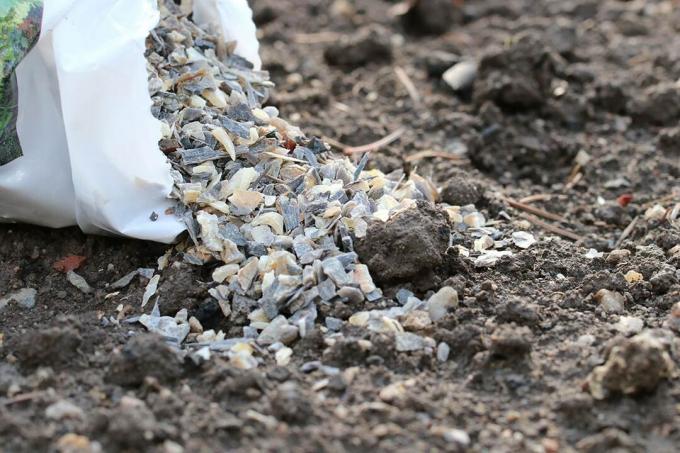
Due to the relatively high nutrient and humus requirements, regular fertilization is required. However, this only starts from the second year of planting, because the soil still benefits from the added substances in new and transplanted plants and otherwise over-fertilization could occur. Optimal fertilization works like this:
- Between April and July: give organic fertilizer twice a month
- Work in compost or humus in spring and fall
- Spread a few handfuls of horn shavings in the fall
Cut
Cutting is not absolutely necessary for the euonymus. Nevertheless, it should be shortened occasionally so that the shrub remains dimensionally stable and does not fall apart in width. In addition, cutting strengthens growth and gives new energy after diseases or severe pest infestations. The optimal cut looks like this:
- Thin out once a year in spring or autumn
- if the flowers are in decline, cut the shoots by half at most
- to correct the height and width in autumn, cut off shoots that are too long close to the ground
- Radical pruning is also possible in the event of severe thinning and/or disease/pest infestation
- radical cut: Cut down to 30 centimeters
- always choose dry weather for cutting (reduces the risk of infection)
A notice:
All parts of a euonymus plant are poisonous and can cause symptoms of poisoning in humans and animals if eaten - especially the seeds. If these get into the organism, it can lead to severe kidney and liver damage and, in the worst case, to death. Due to the toxicity, appropriate precautions should be taken when caring for them, especially when cutting and caring for them during seed formation.
wintering
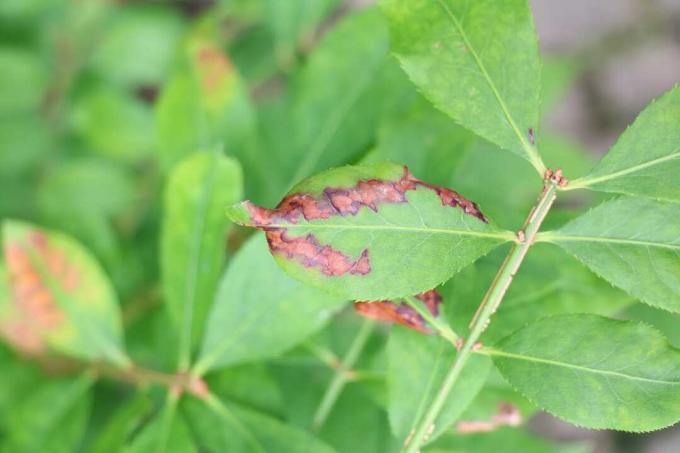
The spindle tree is considered to be very hardy. If it is planted in the garden bed, no additional measures need to be taken for wintering outdoors. The situation is different with tub cultivation, because here the fine roots are much more exposed to the cold. Some measures should be taken by November at the latest:
- place sheltered from the wind
- Lay insulating protection between the bottom of the bucket and the subsoil (e.g. Styrofoam or wooden panels)
- Cover the surface of the soil thickly with straw, leaves, mulch, pine needles or brushwood
propagation
There are various methods of propagation to choose from:
sowing
Seeds are required for sowing, which can be collected from the capsule fruits either in specialist shops or via an existing spindle bush. This propagation variant does not have a high chance of success. If you still want to try it, you should do the following:
- Collect capsule fruits before they burst
- store dry
- Remove seeds from meat coat after capsule opening in autumn
- Sow the seeds immediately in the bed or, if sowing in spring, keep them in a closed, sand-filled container in a cool, dark place
- Distribute seeds uncovered on soil (light germinators)
- first cotyledons often only visible after months
propagation by cuttings
Propagation by cuttings is a very promising variant:
- in the spring, cut off a shoot that is 10 to 15 centimeters long
- Remove flowers and/or fruit buds
- Cut leaves in half to minimize water evaporation
- Place the cuttings in a glass of water or stick them in continuously moist growing soil
- Root formation after about three months
- plant in normal substrate or garden soil after new leaves have formed
- provide protection from the cold during the first winter
Saplings / root suckers
In addition to the propagation of cuttings, the use of saplings or root suckers is also highly recommended. These can be found in the ground area when they protrude from the ground as new shoots or spread over it. Since these come directly from the main root, the separation is to be made here. Then the sapling is to be placed in the soil with the interface and kept evenly moist for the next few weeks. As with the cuttings, the first hibernation must take place with protection against the cold.
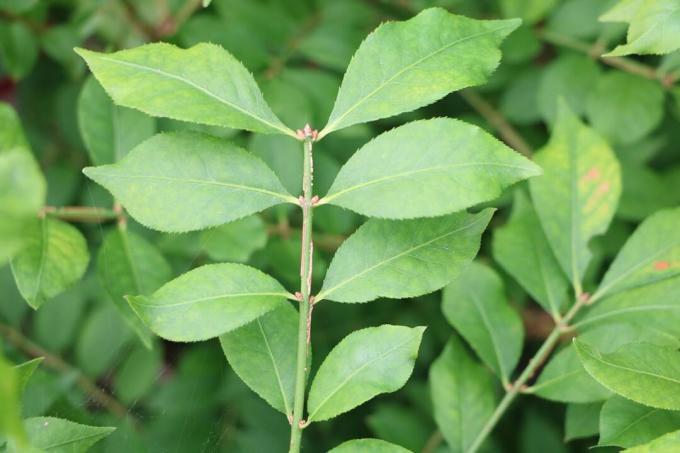
Diseases
Spindle trees are considered to be susceptible to powdery and downy mildew. These are fungal infections that are usually easy to get under control.
powdery mildew
- Mix raw or whole milk with water in a ratio of 1:8
- fill into a spray container and spray the plant until dripping wet
- Duration and frequency of use: every two days for the next two weeks
Wrong mildew
- Chop four cloves of garlic
- Alternative: a medium sized onion
- pour over a liter of boiling water
- Once cool, sift the garlic or onions
- Fill the brew into a spray container and spray the plant parts until dripping wet (especially the undersides of the leaves).
- Duration and frequency of use: every two days for the next two weeks
pests
Spindle Tree Moth(Yponomeuta cagnagella)
The Euonymus shrub is mainly attacked by the spider moth. The moths lay their eggs on them and the offspring do the damage during the development stage of the caterpillar. The caterpillars and moths can be recognized by their typical features/properties:
- Caterpillars: light brown body color and yellow-brown head; form fine, white threads of web, mainly between stems and leaves
- Butterfly: an inch tall; white head with white appendages; wingspan between 18 and 24 millimeters; Wings with black dots
- damage picture: Leaf damage down to leaf veins
Combating the spider moth
Although an infestation with spider moths does not usually pose a life-threatening danger for adult spindle moths, combating it is still useful due to the unsightly loss of leaves. The easiest way to achieve this is to cut out affected shoots and branches.
A notice:
The caterpillars of the spindle moth are easily confused with those of the oak processionary moth. In contrast to these, however, they are absolutely harmless to humans.
 garden editorial
garden editorial I write about everything that interests me in my garden.
Learn more about trees & shrubs

Golden Elm: Care Instructions | 6 cutting tips
From spring to autumn, the golden elm Ulmus hollandica 'Wredei' boasts a unique foliage colour. With its slender growth, it finds space in every garden and sets colorful accents.

Sloe hedge: plant and cut properly
Planting a sloe hedge and trimming it properly is relatively easy with the right knowledge. Because the sloe is easy to care for and at the same time useful for humans and animals. Here you can find out what to look out for when it comes to care.

pruning yew tree | 15 tips for yew rejuvenation
The yew (Taxus) impresses with numerous properties. To ensure that it grows old healthily and develops magnificently in the long term, it needs to be pruned occasionally. Above all, a taper cut is of great importance. With the right tips, it's easy.

Beech - Instructions for care and pruning
Beeches (Fagus) are not only known from forests, public facilities or parks. The beech tree is also becoming increasingly popular in your own garden. Maintenance is pretty easy here. The cut should be carried out according to the instructions so that the tree can freely develop its original growth.

How big does a walnut tree get? | 11 facts about growth
Walnut trees usually have a stately size and often tower over entire stands of trees. They carry tasty and healthy nuts and the wood is also very noble and expensive. They can reach an almost biblical age of 150 years on average.

When does rhododendron bloom? | Beginning and duration of the flowering period
A blooming rhododendron bush casts a spell over everyone. The beautiful flowers, which sometimes appear delicate, sometimes strong pink, violet or even yellow, white or orange, have a very special charm. If you think you can only enjoy this look in spring, you are wrong. The plant is incredibly diverse. Some bushes unfurl their flowers early, while others add color to the gardens in late summer.



